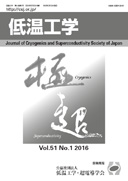All issues

Volume 51, Issue 5
Displaying 1-7 of 7 articles from this issue
- |<
- <
- 1
- >
- >|
Preface
-
Jun-ichi SHIMOYAMA2016 Volume 51 Issue 5 Pages 145
Published: May 25, 2016
Released on J-STAGE: June 22, 2016
JOURNAL FREE ACCESSDownload PDF (610K)
Feature: Current Status and Future Outlook of High Temperature Superconducting
-
Taketsune NAKAMURA2016 Volume 51 Issue 5 Pages 146
Published: May 25, 2016
Released on J-STAGE: June 22, 2016
JOURNAL FREE ACCESSDownload PDF (491K)
Review Article
-
― High-temperature Superconducting Generators and Motors ―Itsuya MUTA2016 Volume 51 Issue 5 Pages 147-154
Published: May 25, 2016
Released on J-STAGE: June 22, 2016
JOURNAL FREE ACCESSIt is said that extensive CO2 emissions is a well-known cause for the crucial temperature rise the Earth is experiencing, so all people of the world need to devise a good way to reduce global CO2 emissions. One mean is to utilize some technologies to improve the efficiency of electrical equipment, such as that used for electric- power generation and power machinery. One of the most effective technologies is thought to be the application of high-temperature superconductivity so as to improve energy conversion efficiency based on the zero resistivity of superconductive winding conductors, together with the use of low iron loss magnetic materials. This paper clarifies a theoretical design philosophy for high-efficiency, small-size and lightweight electric rotating machinery, and reports on a survey of the current status of R&D regarding high-temperature superconducting (HTS) electric rotating machinery. In addition, the paper discusses observations regarding the ulterior solvents for successfully and actually manufacturing HTS electric machinery.View full abstractDownload PDF (1086K)
Focused Reviews
-
Kazuhiro KAJIKAWA, Taketsune NAKAMURA, Hiroaki KOBAYASHI2016 Volume 51 Issue 5 Pages 155-163
Published: May 25, 2016
Released on J-STAGE: June 22, 2016
JOURNAL FREE ACCESSThe research and development conducted regarding fully superconducting motors for liquid-hydrogen transfer pumps using MgB2 monofilamentary wires are gathered into this paper. Synchronous rotation without slip can be realized using squirrelcage-type rotor windings composed of quasi-superconducting loops soldered between MgB2 wires, thereby enabling superconducting motors with low loss and high efficiency to be achieved. The use of MgB2 wires for stator windings also enables the primary winding loss to be reduced drastically compared to conventional copper winding. The transfer of liquid hydrogen from a metal cryostat containing the fabricated MgB2 motor to a glass Dewar vessel for visual monitoring is demonstrated successfully.View full abstractDownload PDF (4335K) -
Kenta YUMOTO, Kyosuke NAKANO, Yoshikatsu HIRATSUKA2016 Volume 51 Issue 5 Pages 164-170
Published: May 25, 2016
Released on J-STAGE: June 22, 2016
JOURNAL FREE ACCESSRecently, practical applications of high-temperature superconducting (HTS) wires are being promoted. Superconducting motor is one of the application for HTS wires, with the advantage of expected higher efficiency. As the performance of the wire was improved, the development of a superconducting motor has been actively conducted. To demonstrate the higher efficiency of electric vehicles driven by a superconducting motor, the development of a superconducting motor and its cooling system has been performed through the joint research of Sumitomo Heavy Industries, Ltd. (SHI) and Sumitomo Electric Industries, Ltd. (SEI). To improve the total efficiency of a superconducting motor system, it is vital to improve cryocooler performance. In this project, SHI developed a high-efficiency Stirling cryocooler and performance tests were conducted. As a result, a cooling capacity of 151 W at 70 K with a compressor input power of 2.15 kW corresponding to a COP of 0.07, was achieved. Actual vehicle testing was also conducted. The results of tests and simulations showed that it is possible to increase efficiency about 10% compared to a conventional electric motor.View full abstractDownload PDF (2009K)
Originals
-
Toru OKAZAKI, Yutaka YAMADA2016 Volume 51 Issue 5 Pages 171-177
Published: May 25, 2016
Released on J-STAGE: June 22, 2016
JOURNAL FREE ACCESSWind-powered thermal energy system (WTES) is the novel idea for utilizing renewable energy as the base-load power source. WTES employs a light and economical heat generator at the top of the tower to convert the rotating energy to the thermal energy. The thermal energy is transferred to the thermal energy storage system, which cost is 1/20 of the batteries. The application of the superconductor to the heat generator enables a higher operating temperature, which leads to the higher efficiency and better use of energy in areas such as fuel production. This paper also describes the situation of energy throughout the world to explain the necessity of WTES.View full abstractDownload PDF (1281K) -
Taketsune NAKAMURA, Hirotoshi SHIMURA, Naoyuki AMEMIYA2016 Volume 51 Issue 5 Pages 178-184
Published: May 25, 2016
Released on J-STAGE: June 22, 2016
JOURNAL FREE ACCESSThis paper presents an analytical study on the temperature dependency of rotating characteristics in hightemperature superconducting induction/synchronous motors based upon the application of a nonlinear electrical equivalent circuit. The nonlinear current transport property of a superconducting BSCCO rotor bar is firstly characterized for different temperatures, and then introduced to the equivalent circuit. The cooling efficiency of a cryocooler is also considered for calculating motor performance. It is shown that the subject motor shows high efficiency for variable rotation speed and torque even when considering cryocooler consumption power.View full abstractDownload PDF (1922K)
- |<
- <
- 1
- >
- >|